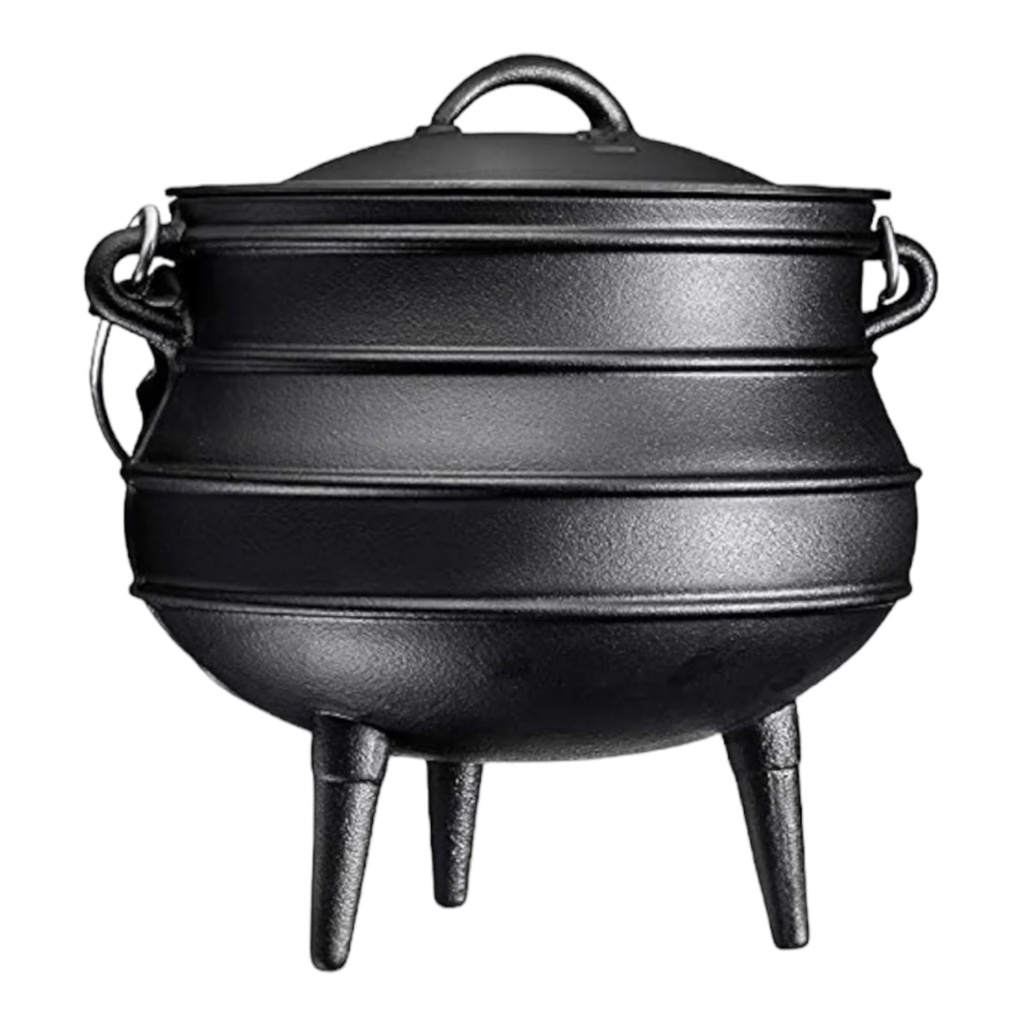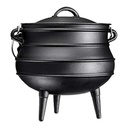Pot 3 Leg No.6 Potjie Cast Iron Black
Pot 3 Leg No.6 Potjie Cast Iron Black
A 3-Leg No. 6 Potjie Pot made of cast iron in black is a traditional, durable, and versatile cooking vessel used for slow cooking, stews, soups, and braais (barbecues). Potjie pots are popular in Southern Africa, especially in South Africa, and have been used for generations.
Here’s a detailed breakdown of the Pot 3 Leg No. 6 Potjie Cast Iron Black:
Specifications
Material: Cast Iron
- The pot is made of high-quality cast iron, which is excellent for heat retention and even distribution. Cast iron is also durable and can last for many years with proper care.
- Black enamel coating: The black color is typically a natural or enamel finish, which helps prevent rust and ensures the pot retains heat efficiently.
Size/Volume: No. 6 Potjie Pot
- A No. 6 Potjie Pot typically has a volume of around 6 liters (approximately 6.3 quarts). This is suitable for cooking meals for a small to medium group, typically 4-6 people.
Shape:
- The pot has a round, deep shape with a flat bottom, perfect for slow-cooking over a fire. The lid is usually domed to allow steam circulation and prevent splattering.
Legs:
- It features 3 sturdy legs, which help the pot stand securely over an open flame or on a cooking tripod. The legs ensure the pot can be placed over a fire, with enough space for heat to circulate underneath.
Lid:
- It often comes with a tight-fitting lid, which helps in locking in moisture and flavor during cooking. The domed lid is particularly useful for creating a pressure-cooking effect, ensuring tender results.
Uses
Slow Cooking:
- Potjie pots are ideal for slow-cooked stews, soups, and braised dishes. The heavy cast iron ensures that food is evenly cooked and retains its moisture over long cooking times.
Outdoor Cooking:
- This pot is commonly used for outdoor cooking, especially over an open fire or a campfire. It’s perfect for a braai (South African barbecue), and it can be placed directly over a fire or suspended from a tripod.
One-Pot Meals:
- Potjies are often used to make one-pot meals. The No. 6 size is great for making hearty dishes like chicken pot pie, lamb stew, or bobotie.
Baking:
- Some people also use Potjie pots for baking bread or cakes because the even heat distribution is perfect for a crisp crust and soft interior.
Serving:
- The Potjie is designed to be served directly at the table. Its rustic, traditional design adds charm to any gathering or outdoor party.
Advantages
Durability:
- Cast iron is incredibly durable and can last for many decades if well-maintained. It’s a material that only improves with age, often developing a natural patina that enhances the flavor of food over time.
Even Heat Distribution:
- One of the standout features of cast iron is its ability to retain and evenly distribute heat, preventing hot spots and ensuring that your food is cooked consistently throughout.
Versatility:
- Potjie pots can be used for a variety of cooking methods, including frying, simmering, and roasting. You can use them on a campfire, stove, or oven, making them suitable for both indoor and outdoor cooking.
Flavor Enhancement:
- Cast iron cooking surfaces tend to enhance the flavor of food over time. As the pot develops a natural seasoning layer, it imparts a unique taste to dishes, particularly stews and meats.
Traditional and Rustic Appeal:
- The traditional design and use of a Potjie pot give it a rustic, charming appearance. It’s perfect for adding a touch of South African culture to gatherings or meals.
Non-stick Qualities:
- With proper seasoning, cast iron develops a non-stick surface that prevents food from sticking and makes cleaning easier.
Long-Lasting Investment:
- While the initial cost might be higher, the durability of cast iron makes the Potjie pot a long-lasting investment that can be passed down through generations.
Disadvantages and Considerations
Weight:
- Cast iron pots are heavy. While they are durable, they can be cumbersome to handle, especially when full of food. Proper lifting techniques are recommended to avoid injury.
Seasoning Care:
- To maintain the non-stick surface and prevent rust, the pot should be seasoned regularly. This involves oiling the pot and heating it to create a protective layer.
Heat Management:
- Cast iron retains heat for a long time, so it’s important to manage the temperature carefully. Overheating the pot can cause food to burn, and the pot may take longer to cool down once removed from the heat source.
Cleaning:
- Cast iron should not be washed with soap, as this can strip away the seasoning. Instead, it should be cleaned with hot water and a brush or scraper. Avoid using abrasive cleaners that could damage the seasoning.
Cost:
- High-quality cast iron can be expensive, but it’s generally a worthwhile investment given its long lifespan and superior cooking properties.
Maintenance Tips
Seasoning: Over time, a Potjie pot should be re-seasoned to maintain its non-stick properties. This is done by applying a layer of cooking oil and baking the pot at a high temperature.
Cleaning: After each use, clean the pot with hot water, and use a brush or non-abrasive cloth to scrub away food particles. Dry it thoroughly to avoid rust. Lightly oil the inside to preserve the seasoning layer.
Storage: Store the pot in a dry place to prevent rust. You can also place a paper towel or cloth inside to absorb moisture during storage.
Conclusion
The 3-Leg No. 6 Potjie Cast Iron Black Pot is a traditional and highly versatile cooking tool, perfect for slow cooking and outdoor meals. Its cast iron construction offers excellent heat retention, durability, and flavor enhancement. While it requires care and maintenance, its long-term benefits and the unique flavors it produces make it an invaluable addition to any kitchen or outdoor cooking setup.



